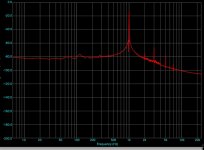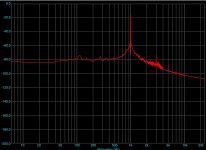I spoke before about following Nelson's lead with the whole modular setup and have a specific question concerning it. If I wanted to put the different FE-nds in a small seperate box and run them off the same rails as the output stage, what kind of connector can carry that voltage and current and what grounding issues would there be? I only hvae to worry about the current that the FE will pull and not what is available, correct.
what kind of connector can carry that voltage and current and what grounding issues would there be? I only hvae to worry about the current that the FE will pull and not what is available, correct.
On the connector front I can recommend Neutrik loudspeaker plugs and sockets (from Maplin in UK) which are rated at 20A or so. They have good soldering and connection surfaces and lock in place. I think you should consider a star ground in your separate front end box connected to star ground in main box linked by shielded three core cable--I have had good results with Supra LoRad 2.5. The latter is very effective, cheap, very flexible and the shield is linked to the earth via a semiconducting earth insulator so you don't need to wire up a separate drain wire.
Chris
I had looked at their standrad XLR and Powercon connectors. Would shielding be beneficial in a DC power connection?
Are you referring to their Speakon connector? Those are very nice.On the connector front I can recommend Neutrik loudspeaker plugs and sockets (from Maplin in UK) which are rated at 20A or so. They have good soldering and connection surfaces and lock in place.
I had looked at their standrad XLR and Powercon connectors. Would shielding be beneficial in a DC power connection?
Absolutely. The longer your wires the longer your aerials. The shielding will not fully protect from RFI but it is better than none. RFI gets into the electronics and screws them up. Expect mid-band hardness and lack of bass definition for example. I was thinking about the post on Supra wire and I've changed my mind. It is a very good shielded mains wire for all the reasons I gave but you really need four wires. The first three are for +, grnd and -ve. the fourth I think should be the drain wire connecting the shielding which I would twist with the outer braid and use this to earth your front end box (if it is metal). I forgot to mention this. So the power grnd goes to your star earth and is connected to the chassis via the Thermistor (CL60). The chassis is also earthed to the mains earth and I think you should connect the earth of the chassis (not star grnd) to the front end box for safety, using the drain/braid of the shielded wire. So the latter joins and two chassis and also grounds (as best it can) any RFI.
I think the Neutrik plug is indeed the Speakon, which on mine has four connection points.
Chris
O.k.
I just measured the amplifikation of my BA-3
Tam, tam it is about 10 times! That means in a good range!
🙂
My R13 is only 300 Ohm, so I suppose with 330 Ohm you will come to a little bit more amplification.
I just measured the amplifikation of my BA-3
Tam, tam it is about 10 times! That means in a good range!
🙂
My R13 is only 300 Ohm, so I suppose with 330 Ohm you will come to a little bit more amplification.
Thanks,
My R13 is 330 and with everything as the schematic says I get 9X. Both of my channels are the same gain so maybe this is the difference between the Fairchild parts and the Toshibas. I'm thinking the 30X was for the BBA-3.
How does your sound? I'll need a few more days to drop mine into the chassis of my old A-75 to have a listen.
🙂
My R13 is 330 and with everything as the schematic says I get 9X. Both of my channels are the same gain so maybe this is the difference between the Fairchild parts and the Toshibas. I'm thinking the 30X was for the BBA-3.
How does your sound? I'll need a few more days to drop mine into the chassis of my old A-75 to have a listen.
🙂
Hi Botte,
When we both have an amplification factor of about 9x, I do not longer understand the explanation of Nelson in the original BA-3 text nor the corrected version of Zen Mod......
But I am happy with an amplification of 9x, much better 🙂
When we both have an amplification factor of about 9x, I do not longer understand the explanation of Nelson in the original BA-3 text nor the corrected version of Zen Mod......
But I am happy with an amplification of 9x, much better 🙂
Have you looked at the data sheet for the transistor that you are using?I do not longer understand the explanation of Nelson in the original BA-3 text nor the corrected version of Zen Mod......
But I am happy with an amplification of 9x, much better 🙂
I think you have to figure in the YFS, forward transfer admittance, which will vary depending on the amount of bias and type of device.
BDP
BDP
I can imagine that in NFB devices the influence or variation of active elements is greater.....but normally I thought that the surrounding passive elements are dominant.
And when I see that Botte and me have the same amplification there must be an explanation!
And when I see that Botte and me have the same amplification there must be an explanation!
For me the amplification is the first stage 100 (r6)/100 (r5) and for the second stage it is 332 (R13)/22 (R10).
So if you change the resistor values the amplification changes.
The devices are transparent to this as far as I see. The get almost out of the equation with this feedback.
albert
So if you change the resistor values the amplification changes.
The devices are transparent to this as far as I see. The get almost out of the equation with this feedback.
albert
Hi Albert,
Thank you for clarifying.....
Do you know why Nelson counts R6+R7/R5 means he has a greater amplification contribution of the first stage and why he also doubles the value of 333/22=15 means 30.
Taken the divisions as truth we even should have an amplification of 60!
Gerd
Thank you for clarifying.....
Do you know why Nelson counts R6+R7/R5 means he has a greater amplification contribution of the first stage and why he also doubles the value of 333/22=15 means 30.
Taken the divisions as truth we even should have an amplification of 60!
Gerd
Generg, what do you mean "P"s?
Also, what soundcard application etc are you using for the 1K test?
Tea
Also, what soundcard application etc are you using for the 1K test?
Tea
Hi tea-bag,
The software was
Electroacoustics Toolbox
Because I like to work with Mac OS, the hardware an E-MU 0204
And the Ps are P1, P2 and P3 from BA-3
It took me one and a have day to get ready with the software and the hardware, there are so many new aspect, for instance Hamming window. So I still do not know what I am doing and choosing, but I managed to get these results.....
The software was
Electroacoustics Toolbox
Because I like to work with Mac OS, the hardware an E-MU 0204
And the Ps are P1, P2 and P3 from BA-3
It took me one and a have day to get ready with the software and the hardware, there are so many new aspect, for instance Hamming window. So I still do not know what I am doing and choosing, but I managed to get these results.....
- Home
- Amplifiers
- Pass Labs
- Burning Amp BA-3

